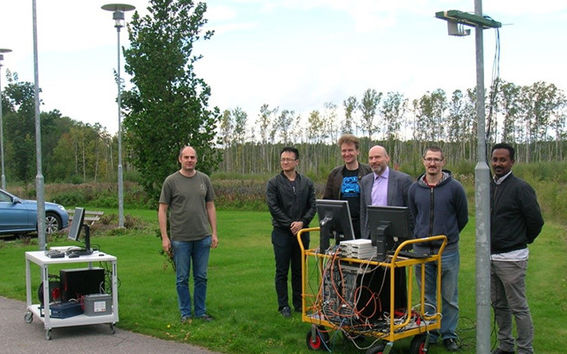Aalto University and Huawei Finland find ways to bring virtual reality to cars and busses over 5G

Researchers from the Department of Communications and Networking, Aalto University, Finland, and 5G Radio Network Technologies, Huawei Technologies Finland, have built a 5G Ultra Dense Network (UDN) testbed to develop ways of bringing high-data-rate services to moving cars and busses. This work is part of a TEKES project TAKE-5.
5G will utilize ever denser networks in cities to reach the challenging capacity requirement. At the same time, ability to provide connected cars and busses with sufficiently high data speed and low enough latency to support future services, such as virtual reality, becomes increasingly important. In order to combine these two trends, it is crucial to develop new ways to handle mobility in small cells. The goal of this testbed is to study such new techniques by equipping lampposts with experimental 5G base stations, developed in close cooperation between Aalto and Huawei that utilize novel mobility algorithms and procedures. The purpose is to show that cars, buses and other moving vehicles, including drones, can enjoy rates up to ten times higher compared to macro cell deployments in cities with seamless flow of data as the vehicle passes the lamppost cells.
The initial test network consists of four base stations, each comprising four antennas. The base stations connect to a centralized controller that handles data flow switching, quality of service and seamless handover between the transmission points. Testbed baseband components are off-the-shelf servers. The testbed's new software architecture simplifies system implementation, testing and addition of new features, and allows usage of a low-capacity wireless backhaul, rather than high-capacity fiber fronthaul. This last feature is critical for cost-efficient small-cell deployments in future.
Users in the test network are tracked by an uplink pilot based localization technique. With this technology the users can be tracked with precision of centimeters. Mobile terminals are not actively involved in the handover procedures, thus reducing the amount of required radio control signaling, increasing handover reliability and battery lifetime as well as simplifying system design. When combined with predictive user mobility models, the test network can perform intelligent proactive handovers resulting in a consistent quality-of-experience for end users throughout the network.
If the results with this small test network are promising, the test network may be trialed in denser city environment in near future.
- Published:
- Updated:
Read more news

Get to know us: Associate Professor Maria Sammalkorpi
Sammalkorpi received her doctorate from Helsinki University of Technology 2004. After her defence, she has worked as a researcher at the Universities of Princeton, Yale and Aalto.
Aalto computer scientists in ICML 2024
Computer scientists in ICML 2024
Getting bacteria into line
Physicists use magnetic fields to manipulate bacterial behaviour